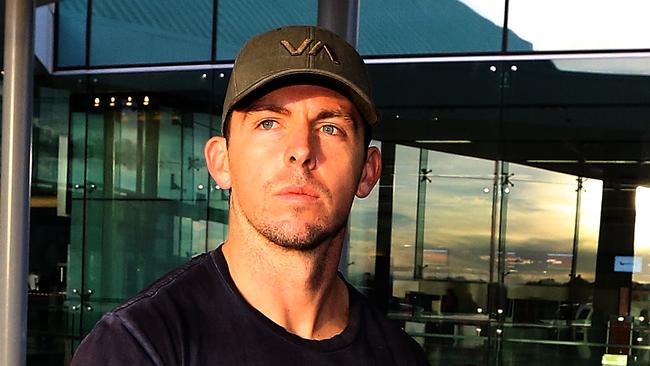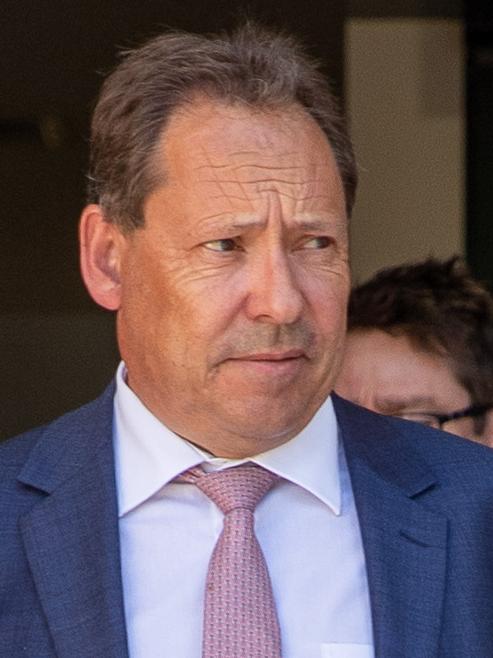Dead man Kumanjayi Walker’s axe charge ‘escalated violent history’
Kumanjayi Walker charged at police brandishing an axe three days before he was fatally shot, a court is told.

Kumanjayi Walker charged at police brandishing an axe three days before he was fatally shot, in what a court heard was a hazardous incident that marked a significant escalation in Walker’s history of violent offending.
On day one of a committal hearing set to decide if Constable Zachary Rolfe will be tried for allegedly murdering Walker during a botched arrest last November 9, the Alice Springs Local Court was played dramatic footage of the tomahawk incident.
It occurred at the home of Walker’s partner, Reckeisha Robertson, in the troubled outback community of Yuendumu, 300km northwest of Alice Springs, where he was living.
In the footage, senior constables Lanyon Smith and Christopher Hand can be seen entering a rundown red house and knocking on the grubby door of a darkened room, from which Ms Robertson soon emerges wailing.
Moments later, Walker, 19, appears shirtless and brandishing a short-handled axe. Commotion ensues before the officers flee and chase Walker into the bush.
The officer in charge of Yuendumu police station, Sergeant Julie Frost, told the court Ms Robertson blocked the doorway, giving Walker time to grab an axe hidden beneath a mattress.
She said the incident was potentially deadly and she later went to see Eddie and Lottie Robertson — referred to as Walker’s grandparents, but actually related to his partner — to attempt to negotiate his peaceful surrender.
“I reiterated the actions of (Walker) were extremely serious — he made it far worse for himself,” Sergeant Frost said in an extract of a police statement read to the court. “I reiterated that what he did could have got my members killed, and (Walker) could have been killed as well or could have been shot because of his actions.”
The court heard that Walker, who had prior convictions for assaulting police and for violence against his partner, was initially given a couple of hours to turn himself in. That was extended to allow him to attend a funeral and memorial concert for a relative.
Sergeant Frost called for reinforcements from Alice Springs and planned for a dog handler and members of the police Immediate Response Team to go with a local officer who knew Walker and arrest him at the Robertsons’ home early on Sunday.

Instead, Walker was shot during a confrontation with IRT team members on Saturday night. No medical staff were in Yuendumu at the time, having evacuated earlier that day in response to a series of break-ins at the nurses’ quarters.
Sergeant Frost said there was no evidence Walker took part in those break-ins but agreed the possibility did cross her mind.
Another witness, Breanna Bonney, struggled to explain why she deleted potentially significant information from drafts of a statement about events leading up to the November 9 shooting.
Constable Bonney was with Constable Rolfe and others in Alice Springs earlier that day and overheard them say they would develop an arrest plan for Walker after arriving in Yuendumu.
She acknowledged deleting the information after speaking to a lawyer but denied doing so to help Constable Rolfe, who she visited immediately after the shooting and spoke to privately.
Philip Strickland SC, acting for the Northern Territory Director of Public Prosecutions, was stopped from pursuing her further when Constable Rolfe’s defence barrister, David Edwardson QC, objected to the crown cross-examining its own witness.
Outside court, prominent Warlpiri leaders addressed a small crowd of Yuendumu community members, activists and bystanders gathered on lawns between the courthouse and police station.

Robin Granites and Valerie Martin urged everyone to respect the justice system and “follow the rules” to achieve fairness.
Ned Jampijinpa Hargreaves loudly objected to Mr Rolfe being out on bail, arguing that any Aboriginal or other layman similarly charged would be locked up, not allowed to live with their family.
Mr Edwardson asked several questions about a police training principle described as “knife equals gun”, meaning the appropriate response to a knife attack was to draw a gun.
Constable Rolfe was stabbed in the shoulder during his confrontation with Walker and briefly hospitalised.
Mr Strickland clarified in questions to the same witnesses that the principle did not mean a gun, once drawn, ought to be fired.
The court heard the body-worn camera footage of the tomahawk incident was shown to officers to prepare them for what they could face when trying to arrest Walker.
The hearing is scheduled to continue on Wednesday.
Constable Rolfe appeared via video link from an undisclosed ACT location. He spoke only to confirm he could hear the judge.



